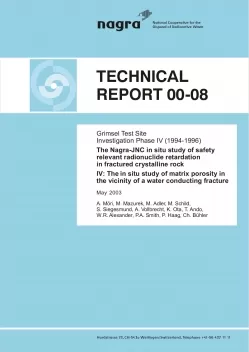
Technical Report NTB 00-08
The Nagra-JNC in situ study of safety relevant radionuclide retardation in fractured crystalline rockIV: The in situ study of matrix porosity in the vicinity of a water conducting fracture
Matrix porosity is a key parameter for the evaluation of various scenarios in the estimation of radionuclide retardation in the geosphere. The amount, shape and size of the pores certainly influence radionuclide retardation, but the degree of connectivity (and therefore the accessibility for contaminants to these pores) must also be taken into consideration.
To date, most assessments of the role of matrix porosity have generally neglected (or have assessed the effects only qualitatively) to quantify the influence of sample disturbance on the geometry and the connectivity of pores, and its impact on the evaluation of total porosity, geophysical and hydraulical parameters. This being the case, this study was initiated to characterise the connectivity of in situ matrix porosity, to quantify the influence of sample preparation on total porosity and to assess the influence of the results on transport models used for performance assessment purposes.
A new technique for in situ impregnation of the diffusion-accessible rock matrix has been jointly developed by Nagra and JNC and successfully applied to the granodiorite matrix behind a water conducting feature at Nagra's Grimsel Test Site (GTS) in Switzerland and JNC's Kamaishi In Situ Test Site (KTS) in Japan. After excavating the conserved rock matrix by overcoring, a large programme of petrographical, petrophysical and chemical analysis was applied to sub-samples taken from the core material outwith any disturbed zone in the rock (e.g. the influence of the injection borehole to the surrounding rock matrix, the tunnel excavation disturbed zone etc.).
The study revealed that the structural and mineralogical heterogeneity in the undeformed matrix of the Grimsel granodiorite is significant and strongly influences type and amount of the dominating porosity. Four different pore types could be distinguished: grain boundary pores, sheet silicate pores, solution pores and microfractures. All these pore types represent a connected network which was accessible for resin within the experimental time scales. Seismic velocity measurements (Vp) on in situ and laboratory-impregnated rock samples as a function of confining pressure, water saturation and spatial direction revealed constraints on the distinction between in situ matrix pores and artificially induced pores. The comparison of conventional porosity determination techniques with a newly developed method to chemically analyse the amount of resin filled pores showed that conventional laboratory determinations on rock samples overestimate the matrix porosity by a factor of 2 to 2.5.
To define the implications of these new data on the efficiency of geosphere retardation of radionuclides released from a repository near-field, scoping calculations based on two existing repository performance assessments were carried out. These revealed that the calculations of radionuclide retardation are relatively insensitive to the magnitude of both the porosity and the pore diffusion coefficient (in the ranges observed in typical repository host rocks). However, the depth of connectivity of the porosity does play an important role, potentially leading to a significant increase in the time of radionuclide breakthrough to the biosphere and to a significant decrease in peak activity of the radionuclides concerned.
The results of this study indicate that, for the two rock types studied here, connected porosity can be shown to exist at significant depths (at least up to several metres) into the matrix behind water conducting features in the rock. Although this work must be repeated in other rock types (and eventually in repository host rocks) to obtain statistically meaningful results, the clear implications are that current assumptions about the retardation properties of the host rock matrix are over-conservative and probably need to be re-evaluated in future repository performance assessments. In addition, the results highlight the dangers of simply transferring laboratoryderived data on geosphere properties to in situ conditions.
